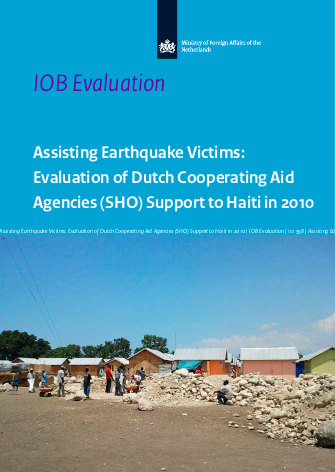
Objectives and scope:
The evaluation aims to provide a comprehensive overview of the activities implemented by the SHO organisations5 in 2010 and to assess their results. The individual organisations are either part of an international network organisation (e.g. Oxfam Novib) or channel all or some of their contributions to an international organisation. This is for instance the case for UNICEF Nederland, which channels its entire financial contribution to UNICEF Headquarters in New York. The Netherlands Red Cross has channelled some of its contribution through the International Federation of the Red Cross and Red Crescent Societies (IFRC) and part through self-implementation. This implies that these two SHO organisations have been contributing to very large programmes implemented by these international organisations and their partners in the field. Other SHO organisations provide direct support either through self-implementation or in collaboration with national implementing counterparts. The evaluation has taken these different modalities into consideration.
The evaluation covers the programmes and projects implemented in the period 13 January - 31 December 2010. It includes all SHO organisations and their affiliates active in Haiti, and pays specific attention to those having the largest share of the expenditure in 2010. The evaluation covers all sectors receiving support.
The first year of SHO support to Haiti was mainly characterised by emergency relief.7 This is also reflected in the mix of activities implemented by the SHO organisations and their partners. The boundary between emergency relief and early recovery, reconstruction and rehabilitation is not always clear. Where appropriate and feasible, the latter are already supported in the emergency phase. Consequently, the evaluation has also covered activities related to recovery and rehabilitation, such as education and health programmes (e.g. rebuilding or refurbishing schools or clinics and hospitals), livelihood programmes (e.g. food-for-work and cash-for-work programmes or the provision of small loans to families and small enterprises), and the establishment of sustainable housing (e.g. the provision of transitional or semi-permanent shelter). Finally, though the evaluation mainly focused on activities taking place in the hardest hit urban areas it also included a number of interventions located in rural or peri-urban areas to which earthquake victims had fled.
Additional Downloads
Links
Resource collections
- Evaluating humanitarian action
- Monitoring of humanitarian action
- Topics
- UN Habitat - Urban Response Collection
- Urban Response - Urban Crisis Preparedness and Risk Reduction
- Urban Response Collection - Community Engagement and Social Cohesion
- Urban Response Collection - Economic Recovery
- Urban Response Collection - Environment and Climate Change
- Urban Response Collection - Housing, Land and Property
- Urban Response Collection - Urban Crisis Response, Recovery and Reconstruction
- Urban Response Collection - Urban Resilience
